#zita of bourbon-parma
Text
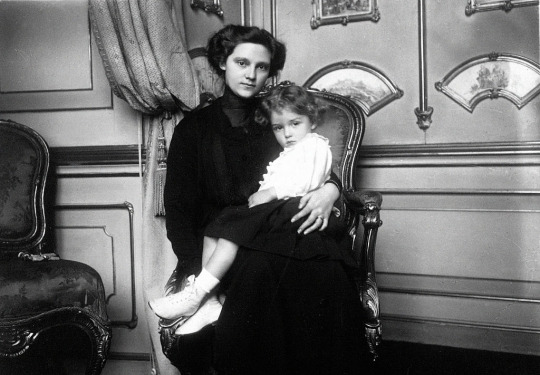
Zita of Bourbon Parma, with her eldest daughter Archduchess Adelheid of Austria.
#zita of bourbon parma#empress zita#adelheid of austria#austria#empress of austria#archduchess#house of habsburg lorraine#long live the queue
56 notes
·
View notes
Text
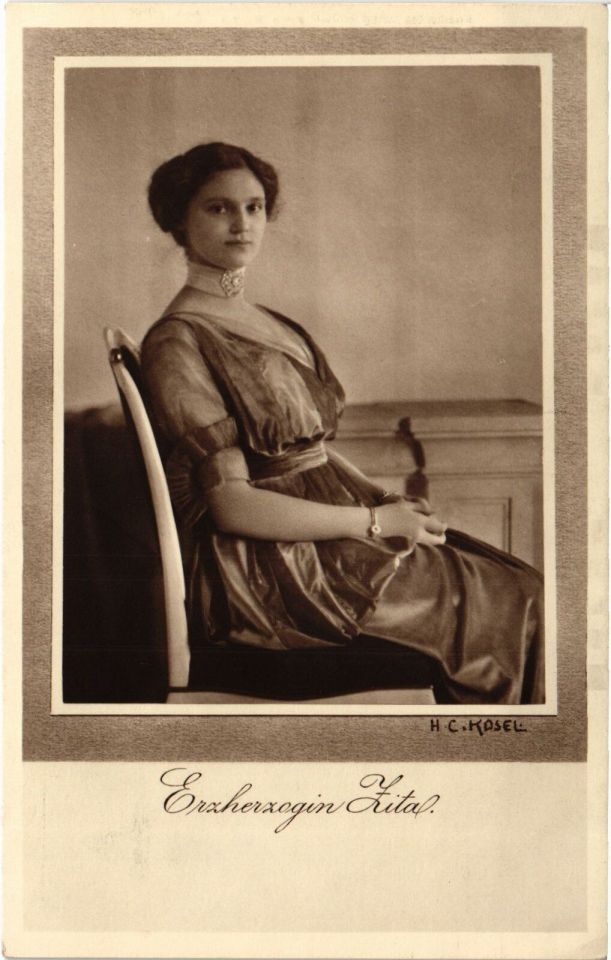
Archduchess Zita Maria delle Grazie Adelgonda Micaela Raffaela Gabriella Giuseppina Antonia Luisa Agnese of Bourbon-Parma
Austrian vintage postcard
#historic#briefkaart#maria#postkaart#raffaela gabriella giuseppina#bourbon#austrian#carte postale#ephemera#archduchess#habsburg#gabriella#tarjeta#photo#antonia#grazie#luisa#postcard#postal#adelgonda#delle#parma#postkarte#agnese#giuseppina#zita#ansichtskarte#adelgonda micaela#antonia luisa agnese of bourbon-parma#sepia
6 notes
·
View notes
Text

1925 Adelheid, Charlotte, Elisabeth and Otto, children of Charles I, the last Emperor of Austria, and Princess Zita of Bourbon-Parma (photo by Schuhmann brothers)
(Österreichischen Nationalbibliothek)
133 notes
·
View notes
Text

Blessed Karl I of Austria (1887 - 1922)
and his spouse, Servant of God Zita of Austria (1892 - 1989)
Emperor and Empress of the Austro-Hungarian Empire
King and Queen of Hungary
Feast Day: October 21
Blessed Charles I or Karl I and Servant of God Zita were the last reigning monarchs of the Austro-Hungarian Empire. He married Zita of Bourbon-Parma in 1911. They were happily married for 11 years yet through the turbulent times of WWI and Karl’s exile. They had 8 children. After Karl’s death, Zita raised her children and served as a symbol of unity for the exiled dynasty. Zita’s and Karl’s hearts are buried together at the Loretto Chapel in Switzerland.
Prints, plaques & holy cards available for purchase. Link in our bio.
55 notes
·
View notes
Text

Wedding photo of Archiduke Karl of Austria and his bride, Princess Zita of Bourbon-Parma.
#emperor karl of austria#empress zita of austria#austrian imperial family#austrian history#house of habsburg
14 notes
·
View notes
Note
what you think sissi was lady diana in 19th century
Hello anon! I actually already talked a bit about this in another ask, but basically no, I don't think so. However, instead of repeating why I don't agree with it, I decided to do something different: look up one of the "Sisi was like Princess Diana" articles and do a counter argument. Just for funsies.
The first article that popped up when I googled "princess diana empress elisabeth" was this one from Vanity Fair, written by Nell Scovell and published in 2015. The main purpose of the article is to boost Allison Pataki's novel about Elisabeth "The Accidental Empress" that I believe was also published around that time. All the quotes going forward are from said article.
Allison Pataki’s latest historical novel, The Accidental Empress, makes a compelling argument that Sisi (as the last Habsburg Empress was known) belongs in the exclusive clique that includes Anne Boleyn, Marie Antoinette, and Princess Diana.
First I'm gonna be extremely annoying and point out that she was the second-to-last empress of the Habsburg empire (herself being born a Wittelsbach). The last empress was Zita of Bourbon-Parma. Second, the only thing in common that those women have is that they became pop icons, but they all lived over a century apart from each other and could not have had more different lives. Well, that's my opinion at least.
“Sisi was arguably the first modern celebrity who operated on a global scale,” Pataki said on the phone recently. “She captured peoples’ hearts and imaginations the way Diana did, and yet, she’s become a footnote in history.”
I'm sorry I can't pay attention to anything else in this quote because "she's become a footnote in history" is INSANE. Like actually crazy. ELISABETH. A FOOTNOTE. ELISABETH!!! One of the most famous women in history!!!! What is she talking about!!!!!
Sorry I needed to get that out of my chest. Moving on. The article actually provides us with a side-by-side list that compares Diana, Princess of Wales and Empress Elisabeth of Austria. Let's break it down and see what parallels we got!

This one has a mistake on Diana's side, she was not royalty, she was from nobility. Elisabeth was a royal highness tho, so that is correct.

Fun fact: Elisabeth and Franz Josef did not meet at Ischl in 1853! Until some weeks ago I thought that they had met for the first time in 1848, when Ludovika went to Innsbruck with her two eldest daughters and her son Karl Theodor, to visit her sister Sophie, who was staying there with her sons to escape the unrest in Vienna (because of you know, the revolution and all that). However, I read in Mythos Kaiserin Elisabeth (run by a blogger that absolutely knows what they are talking about when it comes to Sisi) that their first meeting was in 1843, when Archduchess Sophie visited Possenhofen with Franz Josef. Elisabeth was then only five years old and Franz Josef thirteen. But yeah this comparison feels forced.
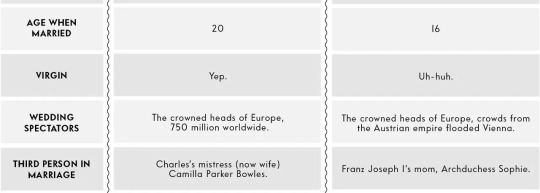
The first one is correct, but I don't see anything worth comparison: royal women tended to marry young. The second one is lowkey gross so I'm ignoring it. I don't have anything to add to the third one other than royal weddings are just Like That, again there is nothing particularly special about either of them to merit a comparison. The last one is super forced jgjgk Franz Josef had mistresses they could've put one of them there instead of Sophie lol.

Ok so I started to do this in a sort of "jaja how funny some of these comparisons are" way but that was before I read this and now I'm writing with anger. Not only this is an absolute reach because these two things are LITERALLY NOT THE SAME AT ALL, LIKE NOT EVEN SIMILAR, comparing prince An*rew, who was accused of terrible crimes and was involved with truly horrible people to Archduke Maximilian on the basis of them being "dicey" is incredibly tasteless. Also, Max did not "declare himself" emperor, he was chosen to be emperor!! There was a plebiscite!!! Ok the plebiscite was rigged but he and Charlotte didn't knew that!!! They truly thought that they were helping the Mexicans!!!
I'm skipping the next two because one can be summoned to "rich women wear jewels" and the other is about their eating disorders, wich is a sensitive subject that I rather not discuss so casually.

No you see Diana and Sisi are super similar because, hmm *rolls dice* Elton John made The Lion King theme song and hmmmm *throws dart* Johann Strauss composed waltzes! This is a totally logic comparison that makes perfect sense and it isn't a reach at all!

I... I don't get this one. Are they saying that John Travolta is like the Shah of Persia or that the Shah of Persia was like John Travolta??

I believe the first one is from an interview. The second one is a private poem Elisabeth wrote soon after she got married. These are two completely different things that should not be compared.

First one: again two different things that have nothing to do with each other at all. Second one: ok I'm not super versed in Diana lore but I'm pretty sure that she was dating Dodi right? Like it wasn't "a fling" they were a couple. And Andrassy was just Elisabeth's friend, in fact she was very proud that their relationship wasn't "poisoned by love". Third one: 19th century journalism was completely different to 20th century journalism and I don't think it should be compared. Last one: I don't recall Elisabeth being called that during her lifetime, although she did like to compare herself to Titania so maybe that's what it's refering to??
Ok we are done! I had put a disclaimer at first about how I didn't want to come off as arrogant or know it all and that this was just me joking, but the list got so stupid that I was like, "actually nevermind I want to be mean", and deleted it jgjdk. But this pretty much sums up my problem with this comparison: Diana and Elisabeth are not really that similar, so people just forces connections between them so they can title their article/video/whatever "learn all about the Diana of the 19th century!!". It's plain clickbait. And worse of all, no one mentions one of the actual connections between them: during her hunting trips in England, Elisabeth stayed at the house of the Earl Spencer, Diana's great-something-grandfather. I believe that that is more worthy to be put in the list than the ridiculous Elton John/Johann Strauss parallel.
Sorry for the rant!
#sorry I ended up being salty jgjgjk I really wanted this to be a funny answer#empress elisabeth of austria#lady diana spencer#asks
8 notes
·
View notes
Photo
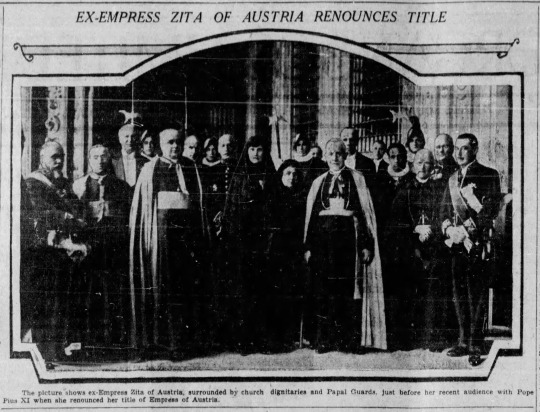
“EX-EMPRESS ZITA OF AUSTRIA RENOUNCES TITLE,” Montreal Star. June 26, 1931. Page 3.
---
The picture shows ex-Empress Zita of Austria, surrounded by church dignitaries and Papal Guards, just before her recent audience with Pope Pius X when she renounced her title of Empress of Austria
#zita of bourbon-parma#rome#papal guards#piux x#empress of austria#habsburg dynasty#end of austria hungary#living in exile#deposed monarch#servant of god#habsburgs#the great depression
1 note
·
View note
Text

The family of Robert I, Duke of Parma. From left to right, first row: Immacolata, Antonia, Isabella, Duke Robert, Henrietta, Luigi, Gaetano, Duchess Maria Antonia, Renato, Zita (sitting on the far right). From left to right, second row: Francesca, Pia, Luisa, Adelaide, Teresa, Joseph, Xavier, Henry, Sixtus, Felix. Villa Pianore, 1906.
(via Zita of Bourbon-Parma - Wikipedia)
1 note
·
View note
Text

Sel. Karl I.
gefeiert am 21. Oktober
Sel. Karl I.
Kaiser von Österreich, König von Ungarn
* 17. August 1887 in Persenbeug in Österreich
† 1. April 1922 in Quinta do Monte bei Funchal auf Madeira in Portugal
Karl aus dem Hause Österreich wurde am 17. August 1887 auf Schloss Persenbeug in Niederösterreich geboren. Seine Eltern waren Erzherzog Otto und Prinzessin Maria Josepha von Sachsen, Tochter des letzten Königs von Sachsen. Kaiser Franz Joseph I. war Karls Großonkel. Karl wurde bewusst katholisch erzogen und von Kindheit an durch eine Gruppe von Menschen im Gebet begleitet, da eine stigmatisierte Klosterfrau große Leiden und Angriffe gegen ihn prophezeit hatte. Daraus entstand nach dem Tod Karls die Kaiser-Karl-Gebetsliga für den Frieden der Völker - seit 1963 als Gebets-Gemeinschaft kirchlich anerkannt. Schon früh wuchs in Karl eine große Liebe zur heiligsten Eucharistie und zum Herzen Jesu. Alle wichtigen Entscheidungen suchte er im Gebet.
Am 21. Oktober 1911 heiratete er Prinzessin Zita von Bourbon‑Parma. In den gut zehn Jahren ihrer glücklichen und vorbildhaften Ehe wurden dem Paar acht Kinder geschenkt. Noch auf seinem Sterbebett sagte Karl zu Zita: »Ich liebe Dich unendlich!« Am 28. Juni 1914 wurde Karl infolge der Ermordung des Erzherzog Thronfolgers Franz Ferdinand durch einen Attentäter zum Thronfolger Österreich‑Ungarns. Mitten im Ersten Weltkrieg machte der Tod Kaiser Franz Josephs Karl am 21. November 1916 zum Kaiser von Österreich. Am 30. Dezember 1916 wurde er zum Apostolischen König von Ungarn gekrönt. Auch diese Aufgabe sah Karl als Weg der Nachfolge Christi: In der Liebe zu seinen Völkern, in der Sorge um sie und in der Hingabe des Lebens für sie. Die heiligste Pflicht eines Königs - für den Frieden zu sorgen - stellte Karl in den Mittelpunkt seiner Bemühungen während des furchtbaren Krieges. Als einziger aller Verantwortlichen unterstützte er die Friedensbemühungen Papst Benedikts XV. Im Inneren bot er in schwierigster Zeit die Hand zu einer umfangreichen und beispielgebenden Sozialgesetzgebung im Sinne der christlichen Soziallehre. Seine Haltung ermöglichte einen Übergang in die Nachkriegsordnung ohne Bürgerkrieg. Dennoch wurde er aus seiner Heimat verbannt. Auf Wunsch des Papstes, der eine kommunistische Herrschaft in Mitteleuropa befürchtete, versuchte Karl, seine Regierungsverantwortung in Ungarn wieder herzustellen. Zwei Versuche scheiterten, da er unbedingt einen Bürgerkrieg vermeiden wollte.
Karl wurde nach Madeira ins Exil geschickt. Da er seine Aufgabe als einen Auftrag Gottes sah, konnte er sein Amt nicht zurücklegen. Er lebte mit seiner Familie verarmt in einem feuchten Haus. Dort zog sich Karl eine tödliche Erkrankung zu, die er als Opfer für Frieden und Einheit seiner Völker annahm. Karl ertrug sein Leid ohne Klagen, verzieh allen, die an ihm schuldig geworden waren, und starb am 1. April 1922 mit dem Blick auf das Allerheiligste. Motto seines Lebens war, wie er noch am Sterbebett sagte: »Mein ganzes Bestreben ist immer, in allen Dingen den Willen Gottes möglichst klar zu erkennen und zu befolgen, und zwar auf das Vollkommenste«.
#seliger karl der 1#karl der 1#letzter kaiser österreichs#kaiser österreichs#österreich#selig#saint#saints#saint of the day#religion#glaube#römisch katholische kirche#gott#christus#christ#jesus#betrachtung#christianity#gebet#catholicism#theology#christentum
0 notes
Text
1 note
·
View note
Photo
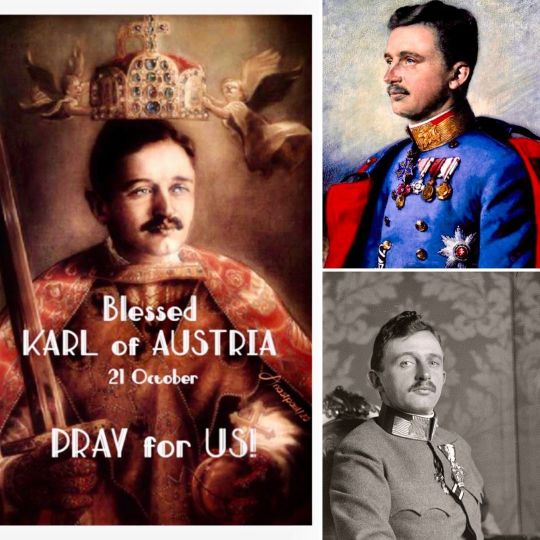
A day late posting. Charles of Austria was born August 17, 1887, in the Castle of Persenbeug in the region of Lower Austria. His parents were the Archduke Otto and Princess Maria Josephine of Saxony, daughter of the last King of Saxony. Emperor Francis Joseph I was Charles' Great Uncle. CHARLES OF AUSTRIA (1887-1922) Charles of Austria was born August 17, 1887, in the Castle of Persenbeug in the region of Lower Austria. His parents were the Archduke Otto and Princess Maria Josephine of Saxony, daughter of the last King of Saxony. Emperor Francis Joseph I was Charles' Great Uncle. Charles was given an expressly Catholic education and the prayers of a group of persons accompanied him from childhood, since a stigmatic nun prophesied that he would undergo great suffering and attacks would be made against him. That is how the “League of prayer of the Emperor Charles for the peace of the peoples” originated after his death. In 1963 it became a prayer community ecclesiastically recognized. A deep devotion to the Holy Eucharist and to the Sacred Heart of Jesus began to grow in Charles. He turned to prayer before making any important decisions. On the 21st of October, 1911, he married Princess Zita of Bourbon and Parma. The couple was blessed with eight children during the ten years of their happy and exemplary married life. Charles still declared to Zita on his deathbed: “I'll love you forever.” Charles became heir to the throne of the Austro‑Hungarian Empire on June 28, 1914, following the assassination of the Archduke Francis Ferdinand. World War I was underway and with the death of the Emperor Francis Joseph, on November 21, 1916 Charles became Emperor of Austria. On December 30th he was crowned apostolic King of Hungary. Charles envisaged this office also as a way to follow Christ: in the love and care of the peoples entrusted to him, and in dedicating his life to them. He placed the most sacred duty of a king - a commitment to peace - at the center of his preoccupations during the course of the terrible war. He was the only one among political leaders to support Benedict XV's peace efforts. https://www.instagram.com/p/CkA3bf6O4Dz/?igshid=NGJjMDIxMWI=
0 notes
Text
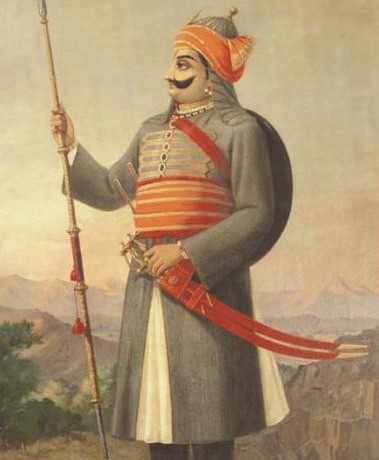
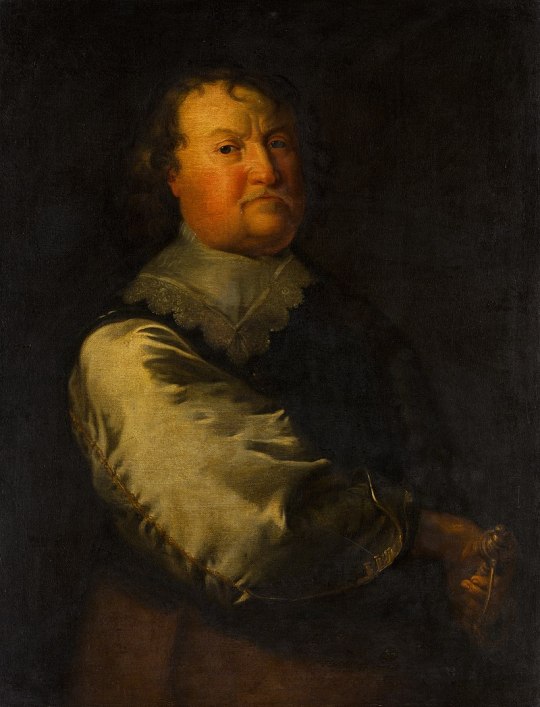
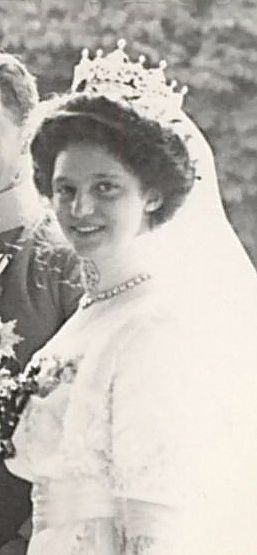
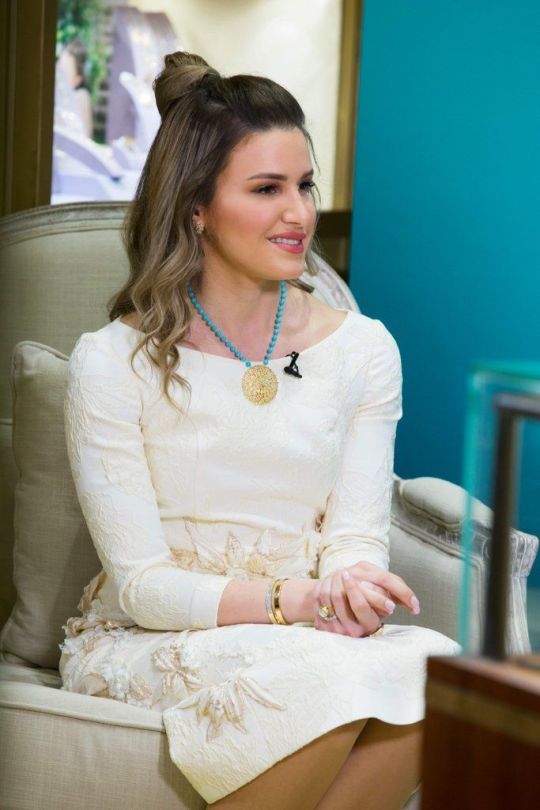
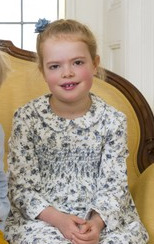
Royal Birthdays for today, May 9th:
Pratap Singh, Maharana of Mewar, 1540
Louis Henry, Prince of Nassau-Dillenburg, 1594
Zita of Bourbon Parma, Empress of Austria, 1892
Nejla bint Asem, Princess of Jordan, 1988
Luisa, Princess of Bourbon Parma, 2013
#luisa of bourbon parma#Nejla bint Asem#Zita of Bourbon Parma#Pratap Singh#Valdemar II#prince louis henry#royal birthdays#long live the queue
5 notes
·
View notes
Photo
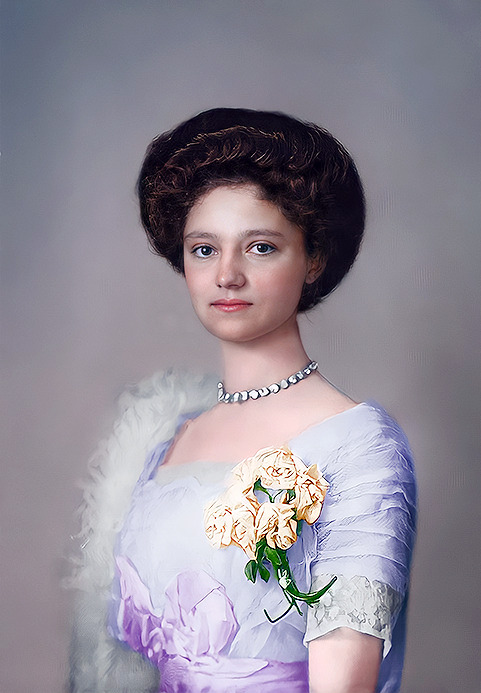
Empress Zita of Austria, consort of Charles I of Austria, 1911.
#Empress Zita of Austria#austrian imperial family#1911#1910s#Zita of Bourbon-Parma#OTMA contemporaries#edwardian
92 notes
·
View notes
Photo

Zita of Parma had been brought up as a nonentity, in an atmosphere of petty interests, religious fanaticism, and more or less worldly frivolity. She is a fond mother, an affectionate wife, and lovely little woman, who cares only for her household duties, and to whom a serious book affords no pleasure to read whilst the English novels published in the Tauchnitz edition are a source of unfailing amusement. She goes regularly to church, fasts on prescribed days, is fond of dancing, and as excited over a ball as any débutante in her season. When the war broke out, she she a few conventional tears, but did not come forward, as she might have been expected to do in her position as wife of the future sovereign, with any attempt to head a humanitarian movement to help the wounded or disabled. She is timid by nature, and perhaps, after all, between her mother-in-law, the Archduchess Maria Josepha, and the Archduchesses Marie Thérèse and Isabella, who started numerous schemes of relief, she felt crushed so far as any desire she might have to personal activity.
36 notes
·
View notes
Photo
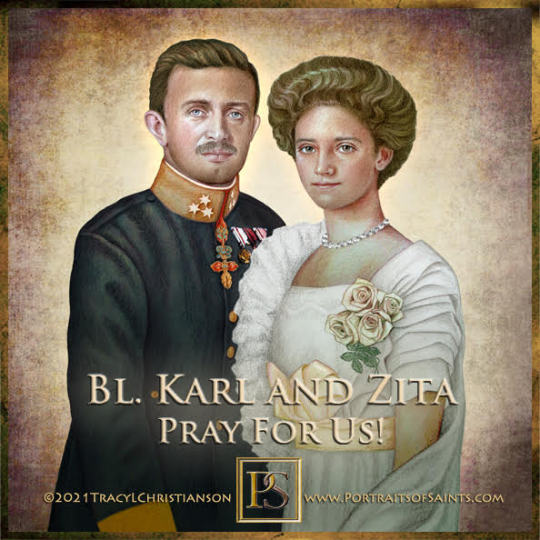
Happy Feast Day
Blessed Karl I of Austria
(1887 - 1922)
Servant of God Zita of Austria
(1892 - 1989)
Emperor and Empress of the Austro-Hungarian EmpireKing and Queen of Hungary
Feast Day: October 21
Blessed Charles I or Karl I and Servant of God Zita were the last reigning monarchs of the Austro-Hungarian Empire. He married Zita of Bourbon-Parma in 1911. They were happily married for 11 years yet through the turbulent times of WWI and Karl’s exile. They had 8 children. After Karl’s death, Zita raised her children and served as a symbol of unity for the exiled dynasty. Zita’s and Karl’s hearts are buried together at the Loretto Chapel in Switzerland.
{website}
84 notes
·
View notes
Text

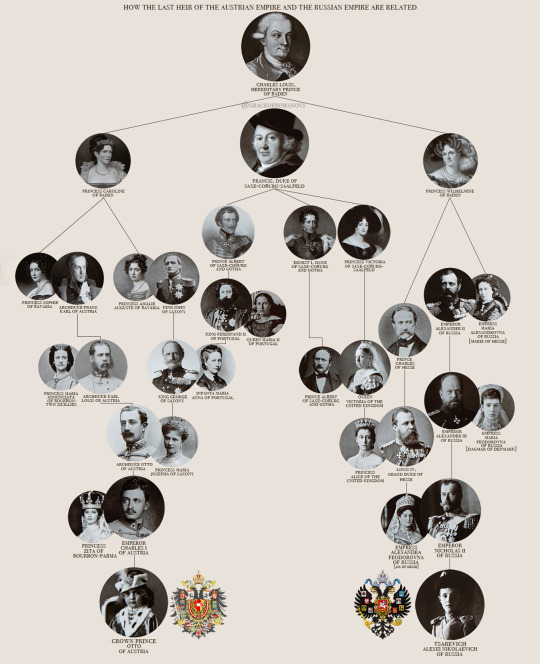
𝐇𝐨𝐰 𝐭𝐡𝐞 𝐥𝐚𝐬𝐭 𝐡𝐞𝐢𝐫𝐬 𝐨𝐟 𝐭𝐡𝐞 𝐀𝐮𝐬𝐭𝐫𝐢𝐚𝐧 𝐄𝐦𝐩𝐢𝐫𝐞 𝐚𝐧𝐝 𝐭𝐡𝐞 𝐑𝐮𝐬𝐬𝐢𝐚𝐧 𝐄𝐦𝐩𝐢𝐫𝐞 𝐫𝐞𝐥𝐚𝐭𝐞𝐝.
Tsarevich Alexei Nikolaevich, the heir to the Russian throne was born in 1904. He was the only son of Emperor Nicholas II and Empress Alexandra Feodorovna. His young life was marked with tragedy, having suffered from haemophilia, a disease which could be traced back to his great-grandmother Queen Victoria. He would be the last heir to the once great Russian Empire, when his father the Tsar abdicated for himself and for his boy in March of 1917. The Tsesarevich would be executed a year later in 1918, alongside his parents and four sisters in the basement of the Ipatiev House.
Crown Prince Otto of Austria, the heir to the Austro-Hungarian throne was born in 1912. He was the eldest son of Emperor Charles I of Austria and Zita of Bourbon-Parma. He became the heir when his father ascended the throne in 1916 until his reigned ended in late 1918, and was officially dethroned in 1919. As his father never abdicated, Otto was considered by himself, his family and Austro-Hungarian legitimists to be the rightful emperor-king from his father's death in 1922. Otto was active on the Austrian and European political stage from the 1930s, both by promoting the cause of Habsburg restoration and as an early proponent of European integration. During his life in exile, he lived in Switzerland, Madeira, Spain, Belgium, France, the United States, and from 1954 until his death, in Bavaria in 2011. At the time of his death, he was a citizen of Germany, Austria, Hungary, and Croatia.
As typical of any royals, both Tsarevich Alexei of Russia and Crown Prince Otto of Austria-Hungary were related more than once, they were 4th cousins once removed twice. Their common ancestors were Francis, Duke of Saxe-Coburg-Saalfeld and Charles Louis, Hereditary Prince of Baden.
#romanovs#history#royalty#nicholas ii#alexandra feodorovna#myedits#tsarevich alexei nikolaevich#charles i of austria#zita of bourbon-parma#otto von habsburg#habsburg#ancestry
110 notes
·
View notes